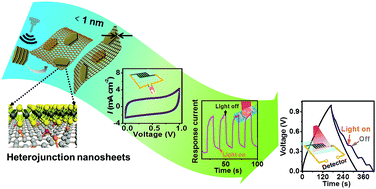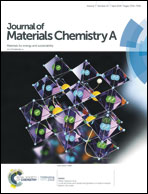Photo-responsive heterojunction nanosheets of reduced graphene oxide for photo-detective flexible energy devices†
Abstract
Bi-layer organization of dissimilar two-dimensional (2D) nanosheets has attracted great attention because of their unique physicochemical properties, fascinating functions, and potential applications in portable and wearable electronic devices. In this study we showed that several types of 2D nanomaterials are capable of being exfoliated by graphene oxide (GO). Under optimal conditions, a concentration up to 1.2 mg mL−1 and an exfoliation yield as high as 24% were achieved for MoS2. The exfoliated transition metal dichalcogenide (TMD) nanosheets anchored in situ onto the surfaces of GO sheets, and formed heterojunction nanosheets due to strong interactions between GO and TMDs based on theoretical calculations. After chemically reducing GO, these heterojunction nanosheets could also be patterned onto biocompatible films of cellulose nanofibrils to construct a flexible planar supercapacitor, with exceptional flexibility, biodegradability, flame retardancy and remarkable energy density (52.7 mW h cm−2). More importantly, the capacitor exhibited intriguing photo-sensitivity, enabling it to be a promising photo-assisted flexible photodetector. Thus the preparation of heterojunction nanosheets not only sheds light on bi-layer organization of 2D nanomaterials, but also promises future applications in wearable, photo-sensitive and flame-retardant electronic devices.



 Please wait while we load your content...
Please wait while we load your content...